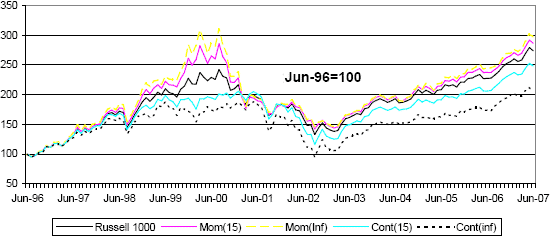Why are there no “momentum” exchange-traded funds (ETF)? What would it take to create them? How might they have performed in recent years? In their November 2008 paper entitled “Momentum and Contrarian Stock-Market Indices”, Jon Eggins and Robert Hill propose a new class of diversified momentum (overweighting stocks that have recently outperformed) and contrarian (underweighting these same stocks) ETFs derived from partitions of a benchmark index. Their methodology allows adjustment of the degree to which a partition is momentum or contrarian via a single parameter, with associated turnover increasing as the degree of momentumness or contrarianness increases. ETFs based on such index partitions would allow individual investors practical access to diversified momentum/contrarian strategies and provide performance benchmarks for momentum and contrarian investment managers. Using price data for the components of the Russell 1000 index over the period June 1995-June 2007 to construct baseline momentum and contrarian indexes, they conclude that:
- Over the entire sample period, short-term momentum and long-term contrarian indexes outperform the reference Russell 1000 index.
- The momentum and contrarian indexes have higher turnovers than does the Russell 1000 index, but a long-only fund sponsor could control turnover to a manageable level while maintaining distinctive momentum and contrarian styles.
- Momentum/contrarian strategies are not simply proxies for growth/value indexes.
- During the “tech” boom, there is high affinity between momentum and growth indexes, and between contrarian and value indexes. These relationships reverse after 2001. Most recently, the relationships disappear.
- Momentum and contrarian indexes generate higher turnover than value and growth indexes (but lower turnover than long-short momentum strategies and many mutual funds).
The following chart, taken from the paper, compares the cumulative performance from June 1996 to June 2007 of the Russell 1000 index and four 12-month formation period, 12-month holding period (12,12) momentum and contrarian indexes derived from it, as follows:
- A (12,12) momentum index with degree of momentumness corresponding to about 23% annual turnover [Mom(15)].
- A (12,12) momentum index with degree of momentumness set to maximum, with annual turnover around 40% [Mom(inf)].
- A (12,12) contrarian index with degree of contrarianness corresponding to about 25% annual turnover [Cont(15)].
- A (12,12) contrarian index with degree of contrarianness set to maximum, with annual turnover around 50% [Cont(inf)].
In general, momentum strategies outperform contrarian strategies for a 12-month holding period, and the momentum-contrarian divergence increases with the degree of index momentumness/contrarianness. Moreover, for a 12-month holding period, momentum (contrarian) strategies tend to outperform (underperform) the reference Russell 1000 index. Contrarians must hold for much longer periods to exploit eventual reversal.
Note that these index performance calculations do not include trading frictions, which might eliminate the outperformance of momentum indexes relative to the Russell 1000.

In summary, momentum and contrarian ETFs based on long-only partitions of broader indexes might offer individual investors practical and diversified access to the momentum factor, and to the associated longer-term contrarian reversal.